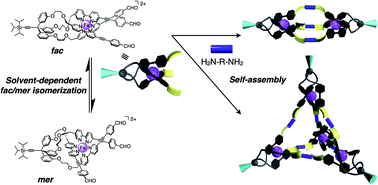Solvent-dependent fac/mer-isomerization and self-assembly of triply helical complexes bearing a pivot part†
Abstract
Tris–chelate metal complexes of unsymmetrical bidentate ligands can form two geometric stereoisomers, facial (fac) and meridional (mer) isomers. Due to the small difference in their properties, the highly-selective synthesis of one of the isomers is challenging. We now designed a series of tripodal ligands with a tris(3-(2-(methyleneoxy)ethoxy)phenyl)methane pivot. Surprisingly, the ratio of the fac/mer isomers of the triply helical FeII complexes significantly changed depending on the solvents. To the best of our knowledge, this is the first example of fac/mer isomerism of a labile tris(2,2′-bipyridine) FeII complex governed by the solvent. Furthermore, well-defined self-assemblies were quantitatively produced by imine bond formation with a suitable diamine. The supramolecular assemblies contained only the fac isomer even though a mixture of the two isomers existed in solution before the condensation reaction. Namely, the self-assembly formation effectively adjusted the geometries of the building unit that results in the suitable supramolecular structure.

- This article is part of the themed collection: Most popular 2021 supramolecular chemistry articles, 2021


 Please wait while we load your content...
Please wait while we load your content...